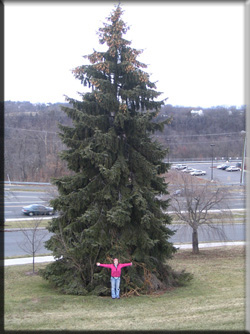Why are trees important?
Trees are important for many different reasons. They absorb Carbon Dioxide in the earth’s atmosphere and release oxygen for aerobic organisms to breath. They provide habitat, food, and other resources for humans and other animals. Humans also use trees in regard to industry and fuel.
You probably know there are trees on your school campus, but you may not know or have wondered what species they are, their age, or how many of them exist. These are important questions to answer when determining your school campus’ biodiversity!
What is biodiversity?
Biodiversity is defined as the number and variety of organisms found within a specified geographic region. In other words, it is not the measure of how MANY organisms (trees, animals, etc.) there are in an area, but how many DIFFERENT SPECIES (or types) there are.
Example: Why biodiversity is important
Biodiversity is important because it provides variation within a particular type of plant or animal that may help ensure survival of related organisms. Have you ever heard the phrase “don’t put all your eggs in one basket”? Think of it like this: if there was only one species of tree in an area and a disease was introduced that killed this specific species, the environment and organisms in that area would be profoundly affected. On the other hand, if there were several different species of trees in the same area that were not affected by the disease, the environment would not lose all of its trees. The same concept can be applied to biodiversity in all living things. Can you think of some other reasons that biodiversity is important?
How can tree biodiversity be measured?
One way to determine tree biodiversity in an area is to take an inventory of the different species of trees that are found there. An easy way to create a list of tree species is to identify them by looking at their leaves. Typically a leaf key is used to provide a logical progression in identifying tree leaves. All you have to do is answer the questions in order! Handouts with a leaf key to common tree species found in Virginia are provided in the links below. If you are unable to identify a tree with these handouts, a link to the FORSite online leaf key can be found below:
How do you know if your campus has “good” tree biodiversity?
A loose rule you may want to follow in determining whether or not your school has good biodiversity or not is to make a list of the different species found in a large area at your school. If there are more than ten species in that area, you can conclude your school campus has “good” biodiversity for an urban area. If there are less than ten different species of tree in the area measured, biodiversity on your school campus may be “poor”.
What trees are found at MY school?
Are you curious to know what tree species are found at your school? Follow the links below to explore some tree species and even specific trees you may find on area school campuses. Also, you will find links to species fact sheets. Click on the links below to view trees you may find at Blacksburg Middle School, Dalton Intermediate, and the Virginia Tech “Grove” (the location of the Jr. Hokie Showcase Fall 2008)! See if you recognize any of the trees in the pictures!
|
